|
This project is a collaboration between Francois Kugel and myself (Jerome Caron). The setup is located in Observatoire de Chante-Perdrix, Dauban (MPC A77). We use an apochromatic refractor d=80mm/f=600mm with a CCD camera ST8300 Sbig. The sensor is a full-frame CCD with 3352x2532 pixels. With this setup the field covered is about 1.3deg*1.7deg. The limiting magnitude is around 15.8. The refractor is mounted onto a HEQ5Pro Sky-Watcher goto mount driven by Prism software. Francois is setting up the telescope every evening with clear sky remotely from his house nearby, and the acquisitions are made automatically over the night. Then I log in from my place in Netherlands in the morning to make the processing. We use the software TeamViewer. Every night, the 80mm refractor is imaging up to 750 fields in the Milky Way (3 images per field). We are covering more than 3000 fields. Then we compare the pictures just taken with pictures taken a few days ago and we search for possible discoveries. We have detected more than 1500 variable stars and compiled our own catalog. We are also following the activity of about 15 dwarf novae and report regular outbursts to the AAVSO list cvnet-ourburst. We show some interesting facts and obtained results below. Some slides describing the survey (in French): survey_presentation_OHP_26-29avril2013.pdf |
 |
15 Aug 2014: end of Dauban survey
The survey is now finished. Last observation took place on 20-July-2014.
In total, 96060 images were acquired between 17-Sept-2012 and 20-July-2014 and processed automatically by the survey scripts. With an average of 4000 stars detected on each image, this makes about 400 millions detections.
Over that period we have detected:
- 7826 known variable stars
- 5521 new, unknown variables
In particular:
- 497 new variables have been published in VSX. Most of them are Mira Ceti stars. There are a few cepheids, one RR Lyrae star and a few eclipsing stars.
We could publish relatively easily 1000 more variables but with 10 to 15 min work for each star, this makes a total time of 250h of very repetitive work that cannot be automated, and seems out of reach for a hobby... In case the publication of these new variables doesn't go any further, we plan to put the list of all their positions (alpha, delta) on Internet.
- we have performed 25 corrections in the GCVS catalog, 2 corrections to the Misao catalog, 88 corrections to the ASAS catalog.
Here again we have about 200 corrections that could be reported, mostly for the ASAS and NSVS catalogs.
We have followed 24 cataclysmic stars: CY Lyr, SS Cyg, AF Cam, V0426 Oph, CZ Ori, NN Cam, SV CMi, CSS 091029:064729+495027, EM Cyg, HL CMa, KU Cas, NSV 2026, TW Vul FO Per, UY Pup, V0795 Cyg, KT Per, NSV 1436, UZ Ser, FS Aur, V1504 Cyg, V0516 Cyg, RZ Sge and IR Gem.
Finally we had 4 alerts:
- 01-June-2013: detection of dward nova PNV J19150199+0719471 several hours after 1st detection by Japanese observers
- 04-July-2013: detection of (already known) symbiotic nova OGLE-2011-BLG-1444 = VVV-NOV-003
- 23-Sept-2013: outburst in Sgr, with very blue spectrum: suspected accretion disk of a black hole candidate, or a blazar (signature from an active galaxy)
- 11-Nov-2013: detection of radioastron, a russian satellite at about 200000 km from Earth in Monoceros
I am deeply grateful to Sebastian Otero and Patrick Wils from AAVSO, who supported this survey by their advices and guidance, and also acknowledged the value of the work we performed with François.
I also would like to thank, for the support, useful discussions, supporting observations or collaborations: Alain Klotz, Klaus Wenzel, Thibaut de France, Jean-François Soulier, Terry Bohlsen, Philippe Dupouy, Jean-François Leborgne, Alain Maury, Emmanuel Conseil, Thierry Garel, Robert Fidrich (the list is not totally exhaustive).
31 Jan 2014: end of outburst in Sgr
A last observation on 31.38 Jan 2014 confirmed that the outburst event detected by us is now finished.
Here is a report that summarizes our observations.
A plot with the final photometry:
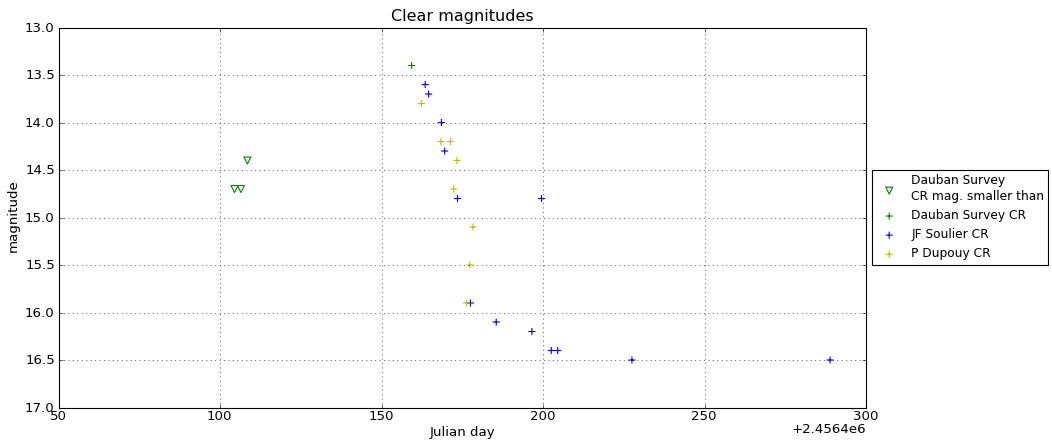
A fit of the spectrum with a power law gives variations in lambda^(-2.4343):
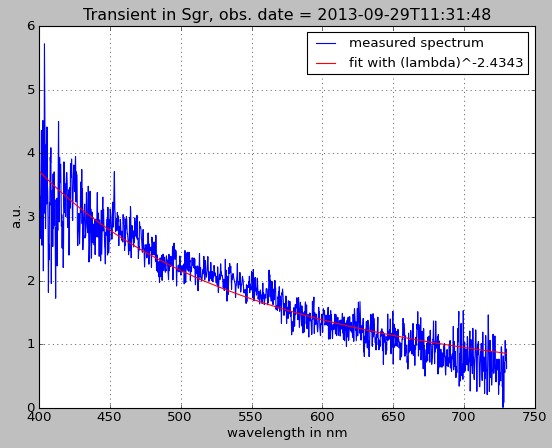
23 Sept 2013: outburst detected in Sgr
More details on this page (French).
English version here.
Our survey scripts have detected a suspect star at the position 18:40:29.13 -27:09:59.3 (J2000.0). We measure it at CR=13.4. The DSS2-R field shows only a faint star close to this position with V=16.8, 17.2 or 17.3 depending on the catalog.
Here's the DSS2-R field and one of the follow-up images (thanks to P.Dupouy):
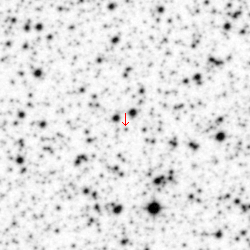
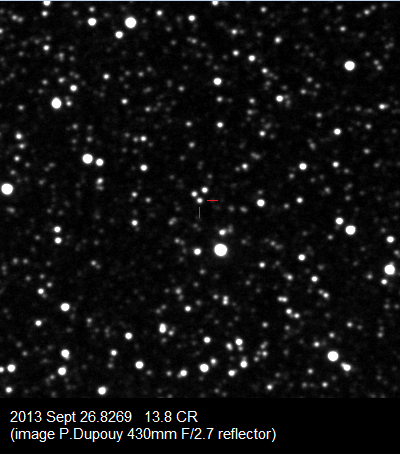
The star is clearly blue. A spectrum has been taken by T.Bohlsen showing a blue continuum and slight Hbeta absorption.
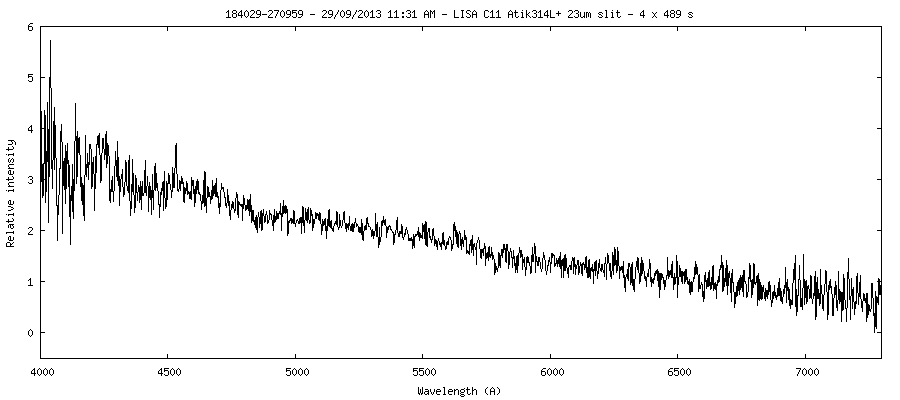
July-August-Sept 2013: corrections for GCVS and Misao stars in VSX
We detected a few variables where the official position indicates a constant star nearby the real variable. Our findings have been confirmed by AAVSO (for all stars) and transmitted to INASAN in Russia (for GCVS stars):
Here's a second batch of corrections for GCVS variables, confirmed by AAVSO and sent to INASAN:
Nova Delphini 2013
We missed it! We observed the position of the nova on Aug 12.0904 UT and did not see any object brighter than mag = 15.2 CR.
We detected it a few days later, see our detection image here.
August-September 2013: fast variables Dauban V239-V250
These variables have been detected by our survey. We perform additional observations with a Meade LX200, to confirm the variability and type.
See the lightcurves for all variables on this page.
So far we succeeded to proove that 8 stars are eclipsing binaries. See for instance this plot for Dauban V242.
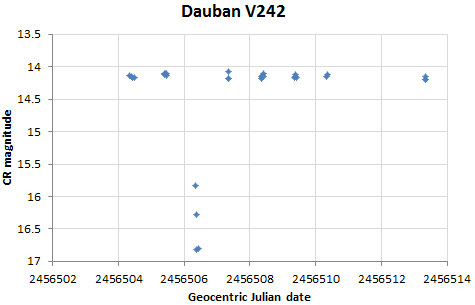
Thibault de France also observed Dauban V248 and found it is a RR Lyrae star!
Based on his data we find a period equal to 0.441454 days.
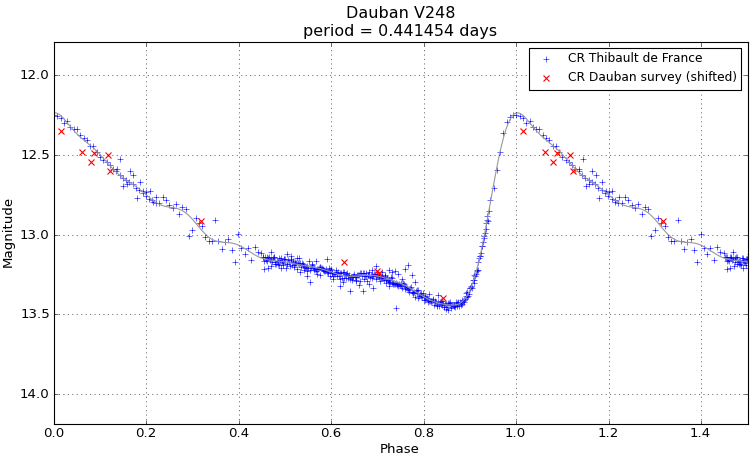
July 2013: observation of cepheids Dauban V16-V17-V18-V19
These 4 bright cepheids have been discovered by our survey. They have periods in the range 11-18 days.
We are making a finer photometry with a 200mm telescope. Here are preliminary results:
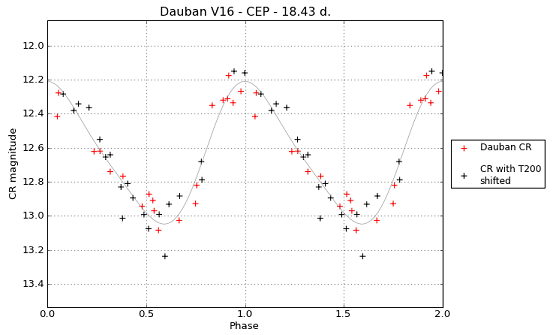
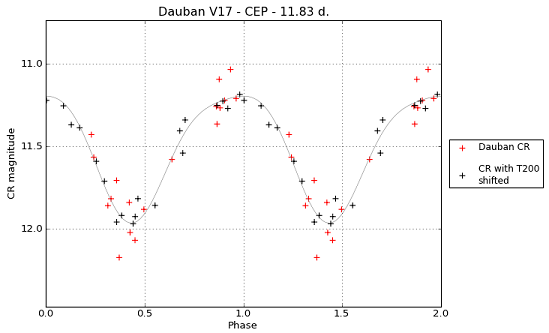
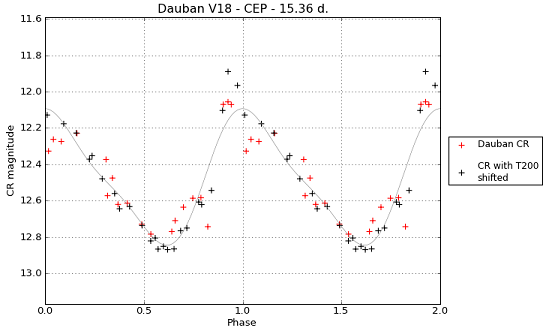
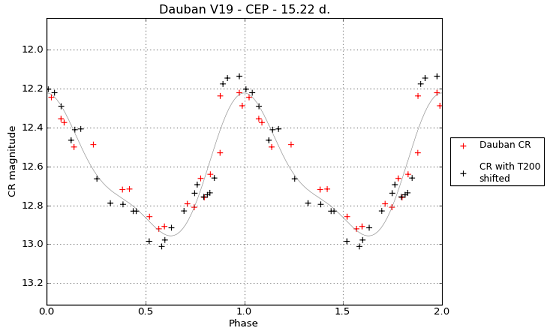
04 July 2013: detection of symbiotic nova OGLE-2011-BLG-1444 = VVV-NOV-003
This star was detected by our survey on 04 July 2013 due to its moderate variability.
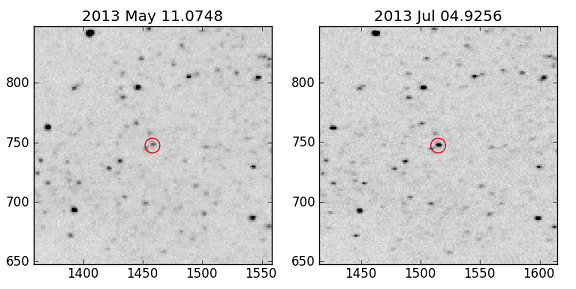
It caught our attention as we could not find any known object at this position on DSS2-IR and 2MASS, which we thought was ruling out the possibility of a Mira. Looking at earlier dates, we found several images from our survey showing the star with a similar brightness over the period from 24 April 2012 to 12 July 2013. We don't have images that go far enough in the past to show the field without the star. So we were a bit confused...
This was actually a very unusual (and rare) type of nova. For more information, see the following links: telegram 5212, telegram 5215, OGLE page.
In 2013 we got the following photometry. Air mass is large for all measurements (~4.5). We use a yellow filter cutting <500nm which hopefully reduces atmospheric effects.
| object 2013 Mar 21.1880 11.5 |
| object 2013 Apr 10.1629 12.1 |
| object 2013 May 11.0748 12.2 |
| object 2013 Jun 01.0127 11.6 |
| object 2013 Jun 04.0204 11.5 |
| object 2013 Jun 15.0242 11.7 |
| object 2013 Jun 25.9484 11.4 |
| object 2013 Jul 04.9256 11.2 |
| object 2013 Jul 12.9040 11.5 |
Our earlier images taken in 2012 suffer from calibration problems and unfortunately cannot be used for photometry. Nevertheless we have very clear images of the star at these dates:
| 2012 Apr 25.1459 | 2012 Jun 21.9690 | 2012 Jul 12.8898 | 2012 Jul 21.8773 |
| 2012 May 02.1057 | 2012 Jun 25.9769 | 2012 Jul 14.8998 | 2012 Jul 25.9078 |
| 2012 May 03.1238 | 2012 Jul 07.9063 | 2012 Jul 16.8981 | 2012 Aug 24.8296 |
| 2012 May 27.0750 | 2012 Jul 10.9200 | 2012 Jul 18.8777 | 2012 Aug 27.8257 |
June 2013: correction in GCVS/VSX
Here is another correction for a GCVS variable star. The correct position was also mentionned in the Skiff catalog for spectral types. The entry in AAVSO-VSX has been updated:
11 May 2013: improved astrometry
I spent a full week of programming to improve the astrometric reduction, with the bad weather helping. Accurate astrometry is essential for measuring magnitudes, because we need to know where to measure on the image, given the alpha and delta coordinates!
The new algorithm was tested with 200 images taken in Sagittarius. This area of the sky is difficult due to visible structures in the Milky Way (giving variable star density, gradients in the sky background) and low elevation. Several images were also contaminated with clouds. Each image was divided in 48 zones, and the median astrometric residual was calculated for each zone. The residuals are below 0.5 pixel in 99.6% of the cases. Here is an histogram of the obtained values:

The new algorithm has additional steps as compared to the one in the online version of Aspylib. The purpose of these extra steps is to make sure that the list of stars used for the fit covers the image uniformly.
April-May 2013: corrections for GCVS stars
We detected new errors about the identity of GCVS variable stars. Our corrections have been accepted by INASAN (in charge of GCVS) in Russia.
The entries in AAVSO-VSX have been updated:
20 April 2013: Dauban catalog update
The Dauban (internal) catalog of variable stars has just been updated.
Over the last 3 months the total number of detected variable stars increased from about 1700 to more than 2700. We have more than 750 discoveries.
| date | known variables | discoveries | total |
| 20-Jan-2013 | 1285 | 477 | 1762 |
| 20-Apr-2013 | 1953 | 768 | 2721 |
18 February 2013: corrections in GCVS
During our observations, we have detected 3 GCVS stars with a mistake about the variable identity (V0348 Cep, V0513 Cep, WY CMi). In all cases, a second star located at 8 to 12 arcsec from the catalogued star, was the true variable. This information has been validated by AAVSO and transmitted to the Institute of Astronomy of the Russian Academy of Sciences (INASAN).
The entries in AAVSO-VSX have been corrected:
Images for V0348 Cep:
On the left, the field image from DSS2-R. The cross shows the old GCVS position, the arrow shows the Dauban detection. The Dauban images are on the right.


11 February 2013: first officialisation of discoveries
The first Dauban variables are published: 15 miras and 2 cepheids!
| name | constellation | J2000.0 | type | mag range | period (days) | AAVSO-VSX |
| Dauban V1 | Vul | 19 40 28.88 +27 00 02.8 | M | 11.4 - 14.6: CR | 355 | link |
| Dauban V2 | Vul | 20 38 07.90 +21 05 21.5 | M | 11.6 - <15.6 V | 228 | link |
| Dauban V3 | Sge | 18 58 21.07 +20 47 57.5 | M | 13.0 - <17.6 V | 271 | link |
| Dauban V4 | Vul | 19 48 55.65 +20 31 40.8 | M | 12.5 - <14.9 CR | -- | link |
| Dauban V5 | Sge | 19 05 38.87 +20 46 26.6 | SRA: | 11.6 - <12.9 CR | 241.9: | link |
| Dauban V6 | Vul | 20 30 46.80 +26 00 38.3 | M: | 11.4 - <12.5 CR | -- | link |
| Dauban V7 | Sge | 19 33 33.27 +19 10 47.8 | M: | 11.8 - <13.7 CR | -- | link |
| Dauban V8 | Vul | 20 38 01.56 +27 54 41.2 | M: | 12.5 - <14.6 CR | -- | link |
| Dauban V9 | Vul | 19 23 22.03 +23 49 25.2 | M: | 11.1 - 14.6: CR | 419: | link |
| Dauban V10 | Vul | 19 28 27.87 +23 11 44.4 | M: | 12.6 - 14.7: CR | 173: | link |
| Dauban V11 | Vul | 19 34 03.37 +20 41 32.1 | M: | 12.8 - <14.6 CR | 379: | link |
| Dauban V12 | Vul | 19 38 07.13 +23 23 54.1 | M: | 12.0 - <14.2 CR | -- | link |
| Dauban V13 | Sge | 20 05 00.58 +20 03 50.3 | M | 15.0 - <17.0 V | 397 | link |
| Dauban V14 | Her | 18 52 44.84 +21 24 10.5 | M | 11.4 - <16.7 V | 331 | link |
| Dauban V15 | Vul | 19 04 38.58 +21 17 04.2 | M | 12.1 - 16.8: CR | 394: | link |
| Dauban V16 | Vul | 20 00 02.48 +29 11 12.8 | CEP: | 12.3 - 13.1 CR | 18.51 | link |
| Dauban V17 | Cyg | 20 16 45.29 +37 07 44.7 | CWA | 11.1 - 12.1 CR | 11.87 | link |
20 January 2013: Dauban catalog update
As of 20 January 2013, we have detected the variability of 1762 stars.
- 1285 of them are known variables.
- 477 are potential discoveries, that do not appear in AAVSO-VSX.
More information here.
29 October 2012: Outburst of TW Vul
This suspected dwarf nova has been seen two times only in outburst, in 1904 and 1927.
We detected an outburst on 29th October 2012.
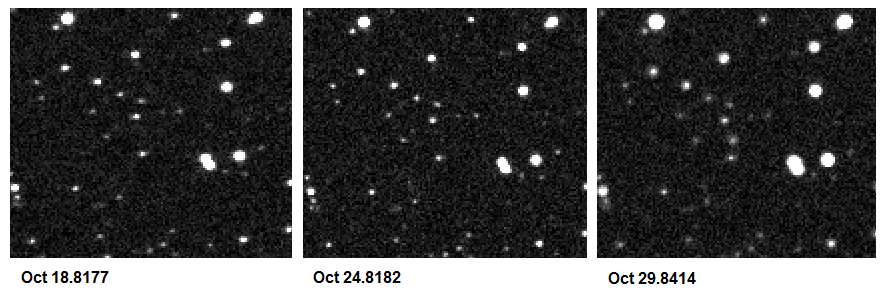
We measured the following magnitudes:
| target | UT (geocentric) | CR magnitude | instrument/exposures | observers |
| TW Vul | 2012 Oct 18.8179 | >15.7 | T80/600, 3*10sec | J.Caron / F.Kugel |
| TW Vul | 2012 Oct 24.8184 | >15.7 | ||
| TW Vul | 2012 Oct 29.8416 | 13.1 | ||
| TW Vul | 2012 Oct 30.7382 | 13.2 | ||
| TW Vul | 2012 Nov 02.8177 | 15.1 | ||
| TW Vul | 2012 Nov 05.8089 | 15.9 | T400 f/3, 5*10sec | F.Kugel / C.Rinner |
| TW Vul | 2012 Nov 06.8030 | >15.5 | T80/600, 3*10sec | J.Caron / F.Kugel |
The AAVSO-VSX entry has been updated: see here.
Klaus Wenzel was very interested by this outburst. He wrote a short publication in a German journal to report our discovery and subsequent observations from other amateurs (Bundesdeutsche Arbeitsgemeinschaft für Veränderliche Sterne, BAV in short). Thanks to him! See here.
01 September 2012: new setup
More information here.
- MAIN PAGE
- References
- v2.0 AND EARLIER
- Download
- Documentation
- MAIN PAGE
- Setup description
- Catalog of discoveries
- Corrections for known variables
- ARCHIVE
- Old setup (Jan 2012-Aug 2012)
- RR Lyr 2012 campaign
- Asteroids and fast variables
- Observation of artificial satellites
- LINKS
- Observatoire Chante-Perdrix Dauban (IAU A77)